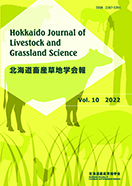Volume 10, Issue 1
Displaying 1-8 of 8 articles from this issue
- |<
- <
- 1
- >
- >|
review-article
-
Article type: review-article
2022Volume 10Issue 1 Pages 1-6
Published: March 25, 2022
Released on J-STAGE: April 12, 2023
Download PDF (518K)
original articles
-
Article type: original articles
2022Volume 10Issue 1 Pages 7-16
Published: March 25, 2022
Released on J-STAGE: April 12, 2023
Download PDF (529K) -
Article type: original articles
2022Volume 10Issue 1 Pages 17-24
Published: March 25, 2022
Released on J-STAGE: April 12, 2023
Download PDF (1049K) -
Article type: original articles
2022Volume 10Issue 1 Pages 25-37
Published: March 25, 2022
Released on J-STAGE: April 12, 2023
Download PDF (4711K) -
Article type: original articles
2022Volume 10Issue 1 Pages 39-46
Published: March 25, 2022
Released on J-STAGE: April 12, 2023
Download PDF (931K) -
Article type: original articles
2022Volume 10Issue 1 Pages 47-53
Published: March 25, 2022
Released on J-STAGE: April 12, 2023
Download PDF (623K) -
Article type: original articles
2022Volume 10Issue 1 Pages 55-61
Published: March 25, 2022
Released on J-STAGE: April 12, 2023
Download PDF (508K)
research notes
-
Article type: research notes
2022Volume 10Issue 1 Pages 63-70
Published: March 25, 2022
Released on J-STAGE: April 12, 2023
Download PDF (878K)
- |<
- <
- 1
- >
- >|
